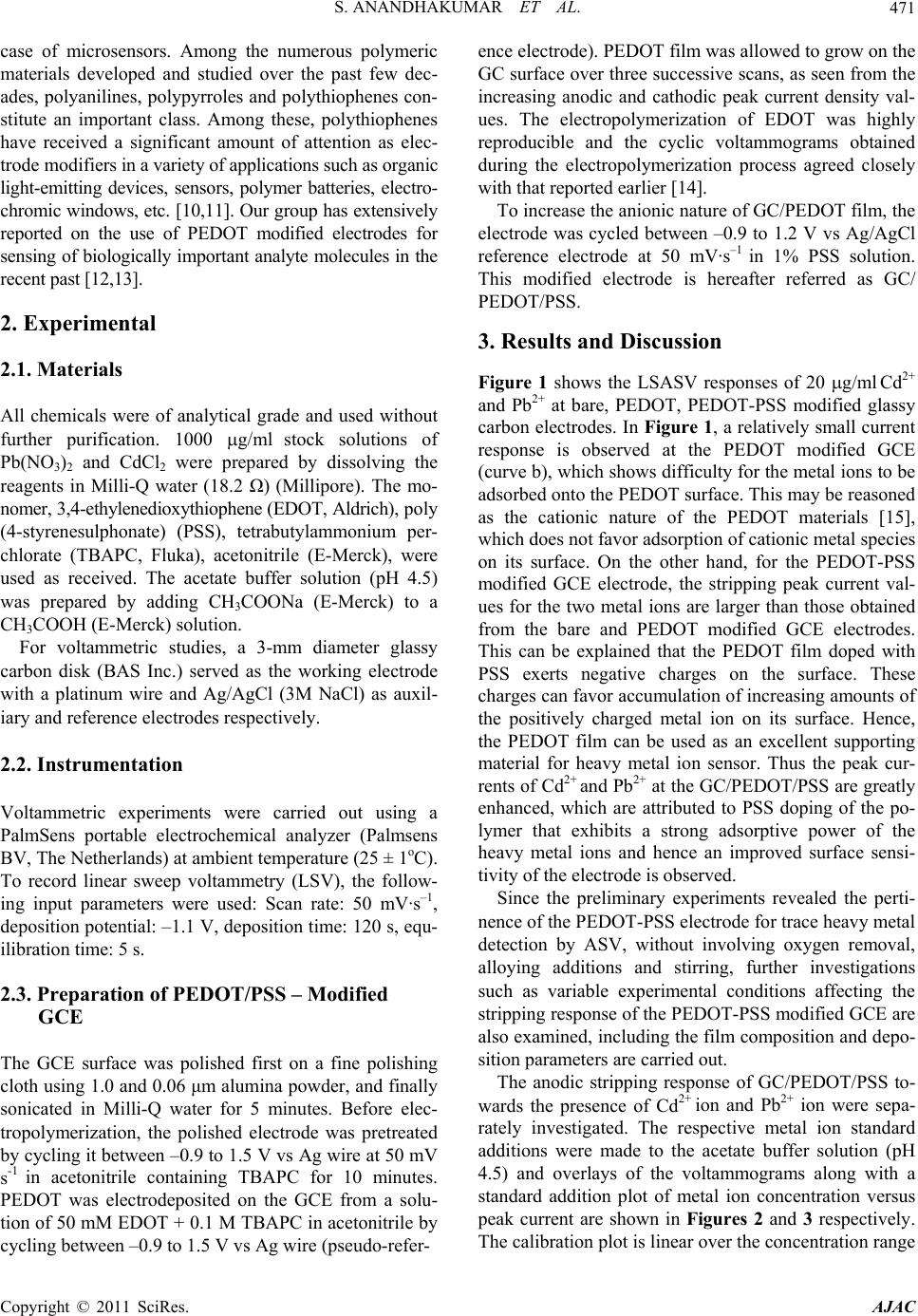
S. ANANDHAKUMAR ET AL.471
case of microsensors. Among the numerous polymeric
materials developed and studied over the past few dec-
ades, polyanilines, polypyrroles and polythiophenes con-
stitute an important class. Among these, polythiophenes
have received a significant amount of attention as elec-
trode modifiers in a variety of applications such as organic
light-emitting devices, sensors, polymer batteries, electro-
chromic windows, etc. [10,11]. Our group has extensively
reported on the use of PEDOT modified electrodes for
sensing of biologically important analyte molecules in the
recent past [12,13].
2. Experimental
2.1. Materials
All chemicals were of analytical grade and used without
further purification. 1000 g/ml stock solutions of
Pb(NO3)2 and CdCl2 were prepared by dissolving the
reagents in Milli-Q water (18.2 Ω) (Millipore). The mo-
nomer, 3,4-ethylenedioxythiophene (EDOT, Aldrich), poly
(4-styrenesulphonate) (PSS), tetrabutylammonium per-
chlorate (TBAPC, Fluka), acetonitrile (E-Merck), were
used as received. The acetate buffer solution (pH 4.5)
was prepared by adding CH3COONa (E-Merck) to a
CH3COOH (E-Merck) solution.
For voltammetric studies, a 3-mm diameter glassy
carbon disk (BAS Inc.) served as the working electrode
with a platinum wire and Ag/AgCl (3M NaCl) as auxil-
iary and reference electrodes respectively.
2.2. Instrumentation
Voltammetric experiments were carried out using a
PalmSens portable electrochemical analyzer (Palmsens
BV, The Netherlands) at ambient temperature (25 ± 1oC).
To record linear sweep voltammetry (LSV), the follow-
ing input parameters were used: Scan rate: 50 mV·s–1,
deposition potential: –1.1 V, deposition time: 120 s, equ-
ilibration time: 5 s.
2.3. Preparation of PEDOT/PSS – Modified
GCE
The GCE surface was polished first on a fine polishing
cloth using 1.0 and 0.06 μm alumina powder, and finally
sonicated in Milli-Q water for 5 minutes. Before elec-
tropolymerization, the polished electrode was pretreated
by cycling it between –0.9 to 1.5 V vs Ag wire at 50 mV
s-1 in acetonitrile containing TBAPC for 10 minutes.
PEDOT was electrodeposited on the GCE from a solu-
tion of 50 mM EDOT + 0.1 M TBAPC in acetonitrile by
cycling between –0.9 to 1.5 V vs Ag wire (pseudo-refer-
ence electrode). PEDOT film was allowed to grow on the
GC surface over three successive scans, as seen from the
increasing anodic and cathodic peak current density val-
ues. The electropolymerization of EDOT was highly
reproducible and the cyclic voltammograms obtained
during the electropolymerization process agreed closely
with that reported earlier [14].
To increase the anionic nature of GC/PEDOT film, the
electrode was cycled between –0.9 to 1.2 V vs Ag/AgCl
reference electrode at 50 mV·s–1 in 1% PSS solution.
This modified electrode is hereafter referred as GC/
PEDOT/PSS.
3. Results and Discussion
Figure 1 shows the LSASV responses of 20 g/ml Cd2+
and Pb2+ at bare, PEDOT, PEDOT-PSS modified glassy
carbon electrodes. In Figure 1, a relatively small current
response is observed at the PEDOT modified GCE
(curve b), which shows difficulty for the metal ions to be
adsorbed onto the PEDOT surface. This may be reasoned
as the cationic nature of the PEDOT materials [15],
which does not favor adsorption of cationic metal species
on its surface. On the other hand, for the PEDOT-PSS
modified GCE electrode, the stripping peak current val-
ues for the two metal ions are larger than those obtained
from the bare and PEDOT modified GCE electrodes.
This can be explained that the PEDOT film doped with
PSS exerts negative charges on the surface. These
charges can favor accumulation of increasing amounts of
the positively charged metal ion on its surface. Hence,
the PEDOT film can be used as an excellent supporting
material for heavy metal ion sensor. Thus the peak cur-
rents of Cd2+ and Pb2+ at the GC/PEDOT/PSS are greatly
enhanced, which are attributed to PSS doping of the po-
lymer that exhibits a strong adsorptive power of the
heavy metal ions and hence an improved surface sensi-
tivity of the electrode is observed.
Since the preliminary experiments revealed the perti-
nence of the PEDOT-PSS electrode for trace heavy metal
detection by ASV, without involving oxygen removal,
alloying additions and stirring, further investigations
such as variable experimental conditions affecting the
stripping response of the PEDOT-PSS modified GCE are
also examined, including the film composition and depo-
sition parameters are carried out.
The anodic stripping response of GC/PEDOT/PSS to-
wards the presence of Cd2+ ion and Pb2+ ion were sepa-
rately investigated. The respective metal ion standard
additions were made to the acetate buffer solution (pH
4.5) and overlays of the voltammograms along with a
standard addition plot of metal ion concentration versus
peak current are shown in Figures 2 and 3 respectively.
The calibration plot is linear over the concentration range
Copyright © 2011 SciRes. AJAC